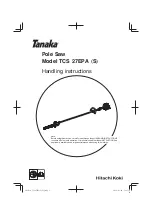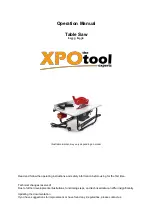
4
FUNCTIONAL DESCRIPTION
1
3
4
8
5
10
2
6
9
7
1.
Handle
2.
Latch
3.
Trigger
4. Lock-off button
5.
Chip container
6. Rip fence slot
7.
Blade
8.
Lower guard
9.
Shoe
10.
Chip viewing window
11.
Spindle lock button
12.
Front Handle
13.
Lower guard lever
14.
Load indicator light
15.
Wrench
16.
Depth setting gauge
17. Depth adjusting lever
15
17
16
12
11
13
14
• The lower guard should be retracted manually
only for special cuts such as “plunge cuts” and
“compound cuts.”
Raise the lower guard by retract
-
ing handle and as soon as blade enters the material,
the lower guard must be released. For all other saw
-
ing, the lower guard should operate automatically.
• Always observe that the lower guard is covering
the blade before placing saw down on bench or
floor.
An unprotected, coasting blade will cause the
saw to walk backwards, cutting whatever is in its path.
Be aware of the time it takes for the blade to stop after
switch is released.
•Do not touch material immediately after it has
been cut. Use caution; cut material may be hot
and sharp.
•Do not use cutting oil.
The use of cutting oil may
cause a fire.
•
Do not use tool near flammable material.
Sparks
may cause fire.
•
Chip container cover may be hot after use.
Use caution when emptying chip container or
changing the blade.
•
Do not start the blade when in contact with
workpiece.
Wait for blade to reach full speed before
beginning cut.
•
WARNING
To reduce the risk of injury, when
working in dusty situations, wear
appropriate respiratory protection or use an
OSHA compliant dust extraction solution.
• Always use common sense and be cautious when
using tools.
It is not possible to anticipate every
situation that could result in a dangerous outcome.
Do not use this tool if you do not understand these
operating instructions or you feel the work is beyond
your capability; contact Milwaukee Tool or a trained
professional for additional information or training
.
•
Maintain labels and nameplates.
These carry im-
portant information. If unreadable or missing, contact
a MILWAUKEE service facility for a free replacement.
•
WARNING
Some dust created by power sanding,
sawing, grinding, drilling, and other
construction activities contains chemicals known to
cause cancer, birth defects or other reproductive
harm. Some examples of these chemicals are:
• lead from lead-based paint
• crystalline silica from bricks and cement and other
masonry products, and
• arsenic and chromium from chemically-treated lumber.
Your risk from these exposures varies, depending on
how often you do this type of work. To reduce your
exposure to these chemicals: work in a well ventilated
area, and work with approved safety equipment, such
as those dust masks that are specially designed to
filter out microscopic particles.
SYMBOLOGY
Volts
Direct Current
No Load Revolutions per Minute (RPM)
C
US
UL Listing for Canada and U.S.





































